The Impact of Cross-Culture on Business Growth: McDonald's Case Study
VerifiedAdded on 2021/02/22
|19
|5190
|196
Report
AI Summary
This report investigates the impact of cross-culture on the business growth of McDonald's, focusing on the challenges and opportunities presented by international expansion. The research begins with an introduction to the concept of cross-culture and its importance in a globalized business environment. The methodology section details the research approach, including qualitative methods, interpretivism philosophy, and a descriptive research design. Data collection methods, specifically primary research using questionnaires with a random sampling technique, are outlined. The report aims to identify the concept of cross-culture, determine the barriers faced by McDonald's in expanding globally, and analyze ways to minimize the impact of these barriers. The study explores the rationale behind the research, the research questions, and the objectives. The report also covers data analysis techniques and ethical considerations, providing a comprehensive overview of the research process and findings.
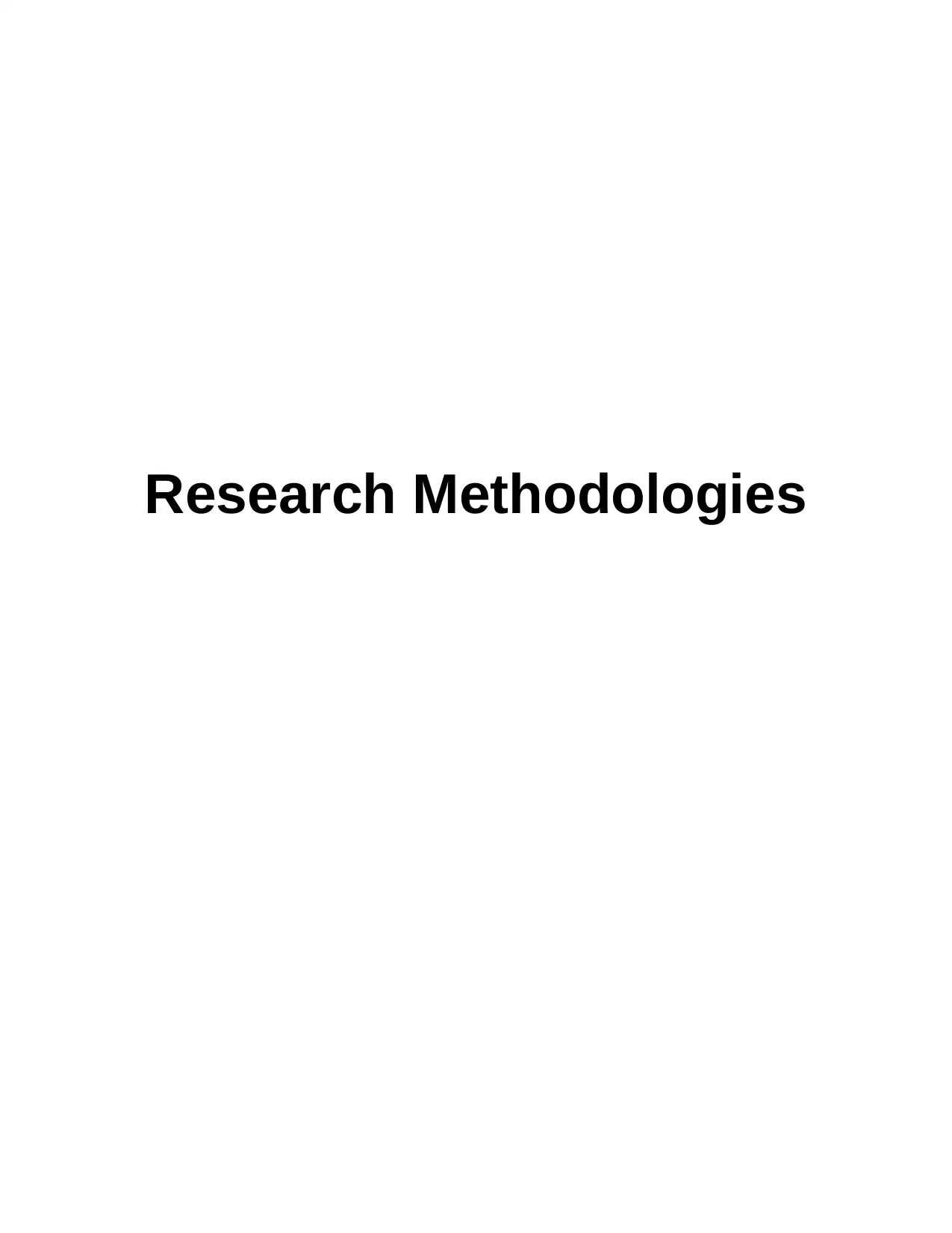
Research Methodologies
Paraphrase This Document
Need a fresh take? Get an instant paraphrase of this document with our AI Paraphraser
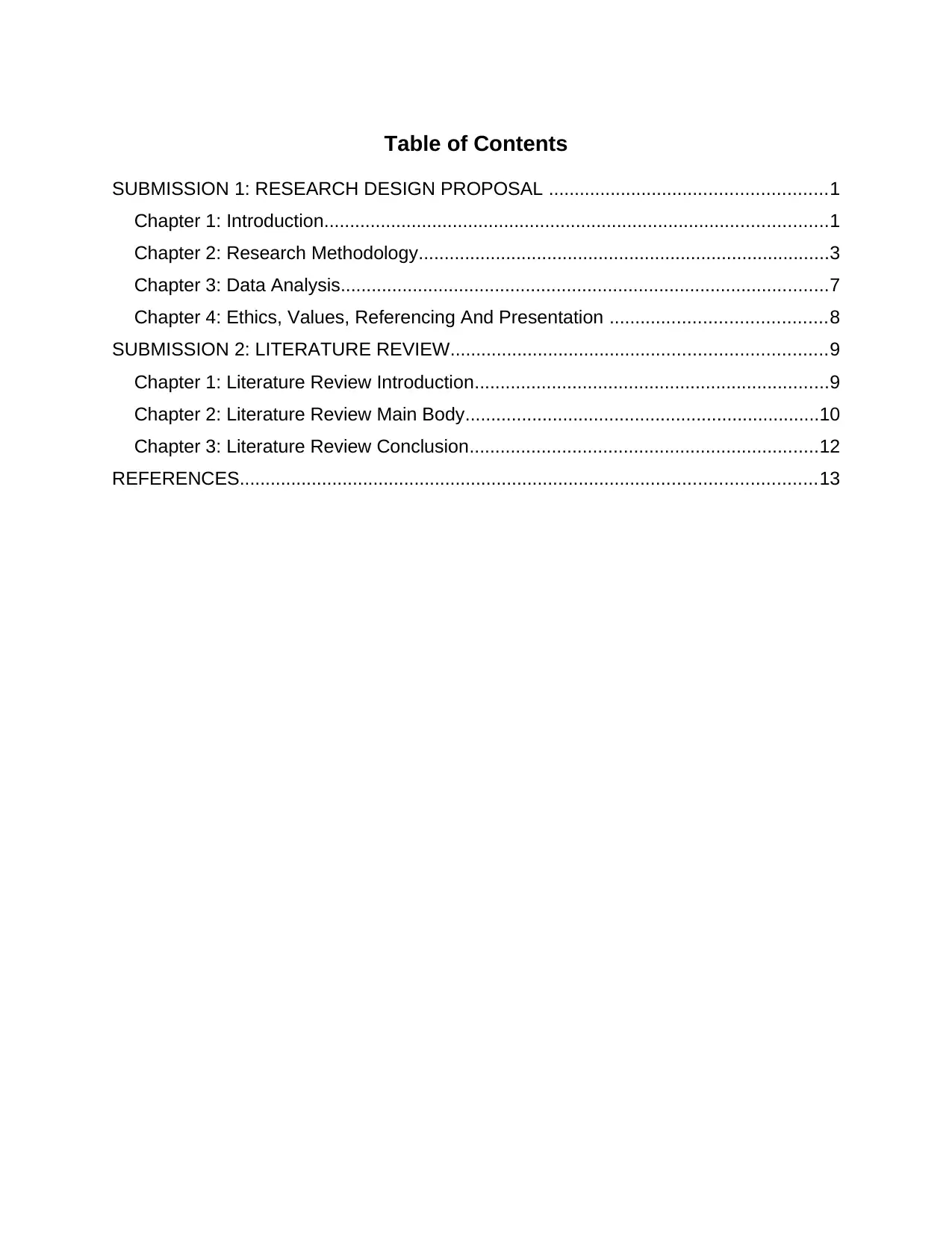
Table of Contents
SUBMISSION 1: RESEARCH DESIGN PROPOSAL ......................................................1
Chapter 1: Introduction..................................................................................................1
Chapter 2: Research Methodology................................................................................3
Chapter 3: Data Analysis...............................................................................................7
Chapter 4: Ethics, Values, Referencing And Presentation ..........................................8
SUBMISSION 2: LITERATURE REVIEW.........................................................................9
Chapter 1: Literature Review Introduction.....................................................................9
Chapter 2: Literature Review Main Body.....................................................................10
Chapter 3: Literature Review Conclusion....................................................................12
REFERENCES................................................................................................................13
SUBMISSION 1: RESEARCH DESIGN PROPOSAL ......................................................1
Chapter 1: Introduction..................................................................................................1
Chapter 2: Research Methodology................................................................................3
Chapter 3: Data Analysis...............................................................................................7
Chapter 4: Ethics, Values, Referencing And Presentation ..........................................8
SUBMISSION 2: LITERATURE REVIEW.........................................................................9
Chapter 1: Literature Review Introduction.....................................................................9
Chapter 2: Literature Review Main Body.....................................................................10
Chapter 3: Literature Review Conclusion....................................................................12
REFERENCES................................................................................................................13
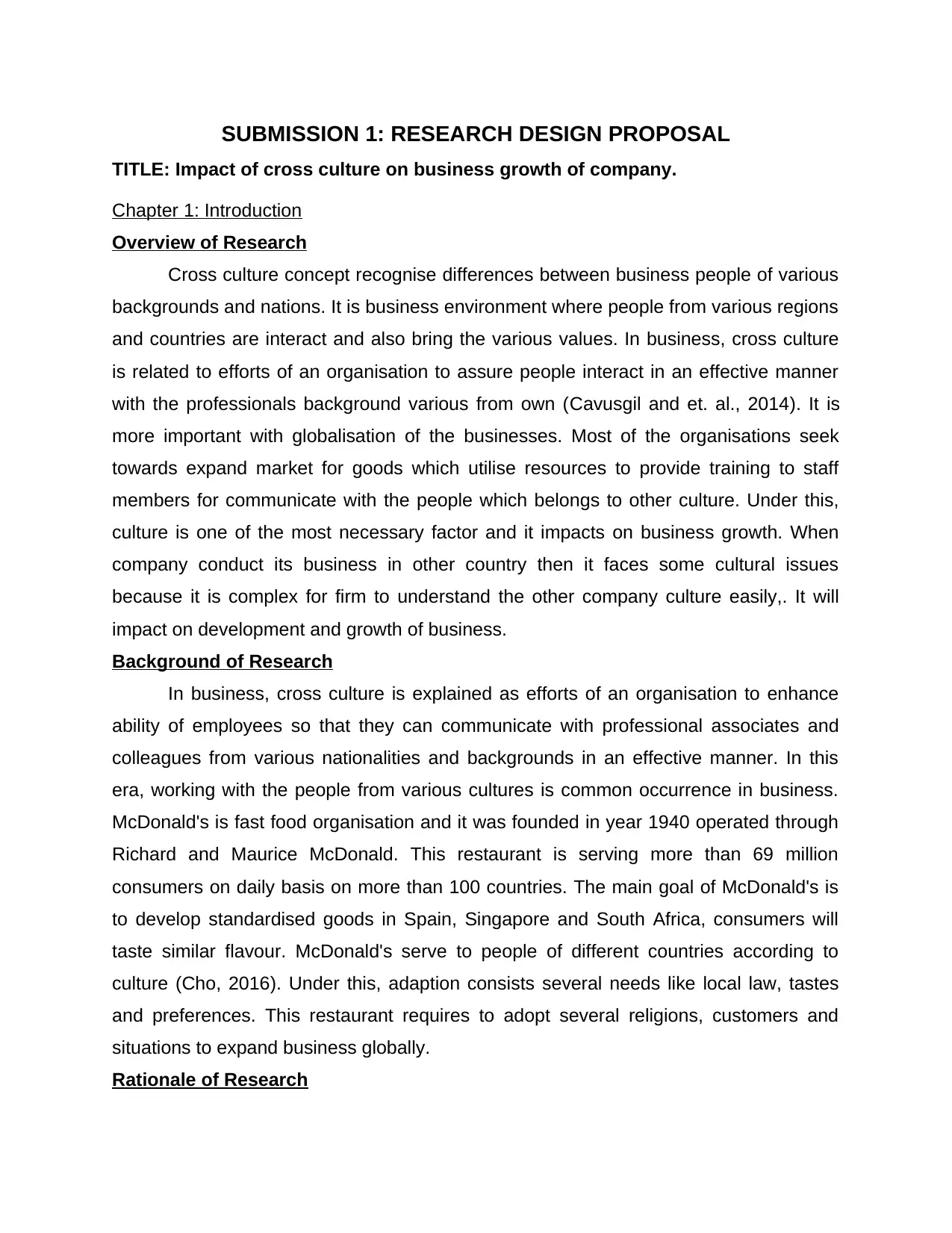
SUBMISSION 1: RESEARCH DESIGN PROPOSAL
TITLE: Impact of cross culture on business growth of company.
Chapter 1: Introduction
Overview of Research
Cross culture concept recognise differences between business people of various
backgrounds and nations. It is business environment where people from various regions
and countries are interact and also bring the various values. In business, cross culture
is related to efforts of an organisation to assure people interact in an effective manner
with the professionals background various from own (Cavusgil and et. al., 2014). It is
more important with globalisation of the businesses. Most of the organisations seek
towards expand market for goods which utilise resources to provide training to staff
members for communicate with the people which belongs to other culture. Under this,
culture is one of the most necessary factor and it impacts on business growth. When
company conduct its business in other country then it faces some cultural issues
because it is complex for firm to understand the other company culture easily,. It will
impact on development and growth of business.
Background of Research
In business, cross culture is explained as efforts of an organisation to enhance
ability of employees so that they can communicate with professional associates and
colleagues from various nationalities and backgrounds in an effective manner. In this
era, working with the people from various cultures is common occurrence in business.
McDonald's is fast food organisation and it was founded in year 1940 operated through
Richard and Maurice McDonald. This restaurant is serving more than 69 million
consumers on daily basis on more than 100 countries. The main goal of McDonald's is
to develop standardised goods in Spain, Singapore and South Africa, consumers will
taste similar flavour. McDonald's serve to people of different countries according to
culture (Cho, 2016). Under this, adaption consists several needs like local law, tastes
and preferences. This restaurant requires to adopt several religions, customers and
situations to expand business globally.
Rationale of Research
TITLE: Impact of cross culture on business growth of company.
Chapter 1: Introduction
Overview of Research
Cross culture concept recognise differences between business people of various
backgrounds and nations. It is business environment where people from various regions
and countries are interact and also bring the various values. In business, cross culture
is related to efforts of an organisation to assure people interact in an effective manner
with the professionals background various from own (Cavusgil and et. al., 2014). It is
more important with globalisation of the businesses. Most of the organisations seek
towards expand market for goods which utilise resources to provide training to staff
members for communicate with the people which belongs to other culture. Under this,
culture is one of the most necessary factor and it impacts on business growth. When
company conduct its business in other country then it faces some cultural issues
because it is complex for firm to understand the other company culture easily,. It will
impact on development and growth of business.
Background of Research
In business, cross culture is explained as efforts of an organisation to enhance
ability of employees so that they can communicate with professional associates and
colleagues from various nationalities and backgrounds in an effective manner. In this
era, working with the people from various cultures is common occurrence in business.
McDonald's is fast food organisation and it was founded in year 1940 operated through
Richard and Maurice McDonald. This restaurant is serving more than 69 million
consumers on daily basis on more than 100 countries. The main goal of McDonald's is
to develop standardised goods in Spain, Singapore and South Africa, consumers will
taste similar flavour. McDonald's serve to people of different countries according to
culture (Cho, 2016). Under this, adaption consists several needs like local law, tastes
and preferences. This restaurant requires to adopt several religions, customers and
situations to expand business globally.
Rationale of Research
⊘ This is a preview!⊘
Do you want full access?
Subscribe today to unlock all pages.

Trusted by 1+ million students worldwide
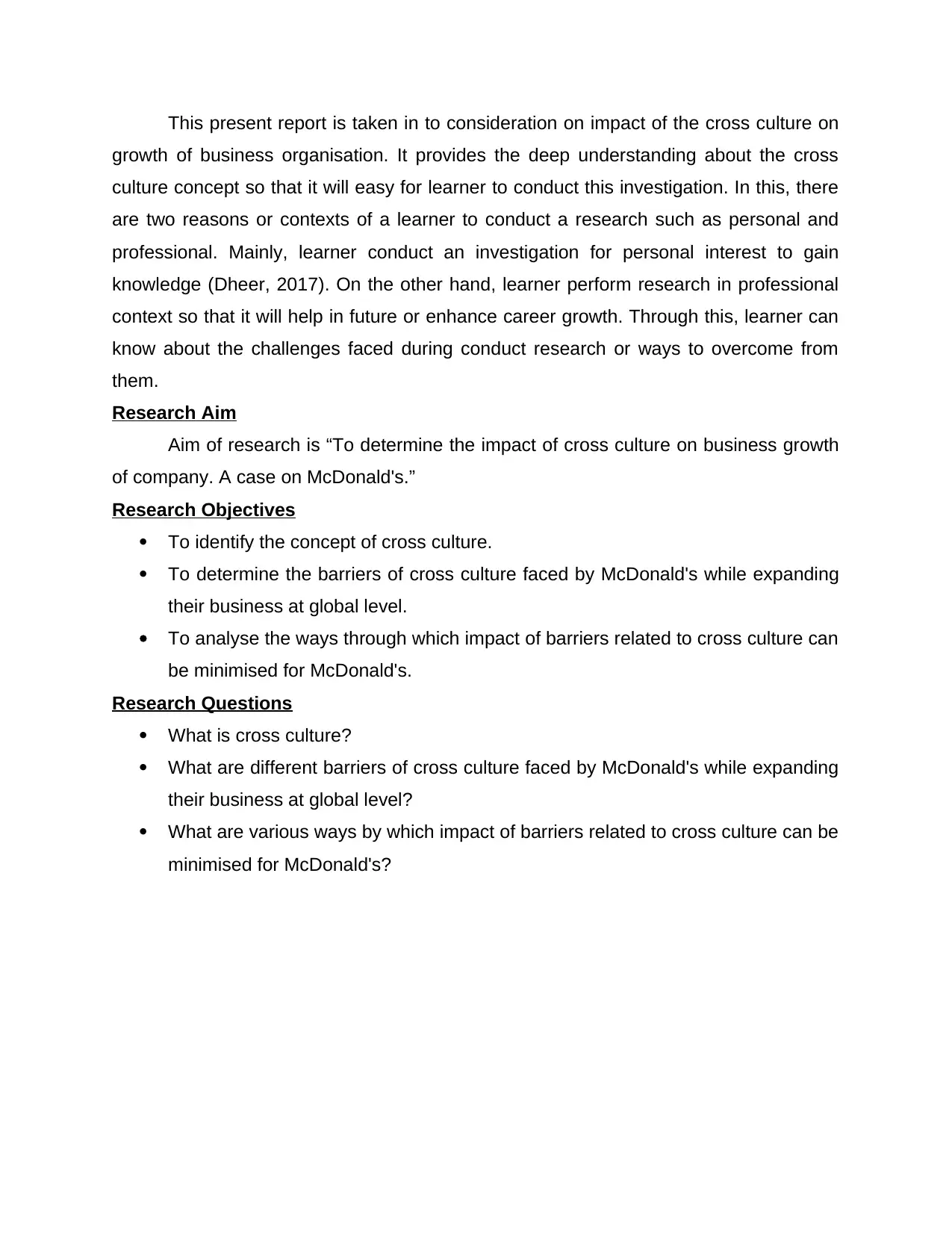
This present report is taken in to consideration on impact of the cross culture on
growth of business organisation. It provides the deep understanding about the cross
culture concept so that it will easy for learner to conduct this investigation. In this, there
are two reasons or contexts of a learner to conduct a research such as personal and
professional. Mainly, learner conduct an investigation for personal interest to gain
knowledge (Dheer, 2017). On the other hand, learner perform research in professional
context so that it will help in future or enhance career growth. Through this, learner can
know about the challenges faced during conduct research or ways to overcome from
them.
Research Aim
Aim of research is “To determine the impact of cross culture on business growth
of company. A case on McDonald's.”
Research Objectives
To identify the concept of cross culture.
To determine the barriers of cross culture faced by McDonald's while expanding
their business at global level.
To analyse the ways through which impact of barriers related to cross culture can
be minimised for McDonald's.
Research Questions
What is cross culture?
What are different barriers of cross culture faced by McDonald's while expanding
their business at global level?
What are various ways by which impact of barriers related to cross culture can be
minimised for McDonald's?
growth of business organisation. It provides the deep understanding about the cross
culture concept so that it will easy for learner to conduct this investigation. In this, there
are two reasons or contexts of a learner to conduct a research such as personal and
professional. Mainly, learner conduct an investigation for personal interest to gain
knowledge (Dheer, 2017). On the other hand, learner perform research in professional
context so that it will help in future or enhance career growth. Through this, learner can
know about the challenges faced during conduct research or ways to overcome from
them.
Research Aim
Aim of research is “To determine the impact of cross culture on business growth
of company. A case on McDonald's.”
Research Objectives
To identify the concept of cross culture.
To determine the barriers of cross culture faced by McDonald's while expanding
their business at global level.
To analyse the ways through which impact of barriers related to cross culture can
be minimised for McDonald's.
Research Questions
What is cross culture?
What are different barriers of cross culture faced by McDonald's while expanding
their business at global level?
What are various ways by which impact of barriers related to cross culture can be
minimised for McDonald's?
Paraphrase This Document
Need a fresh take? Get an instant paraphrase of this document with our AI Paraphraser
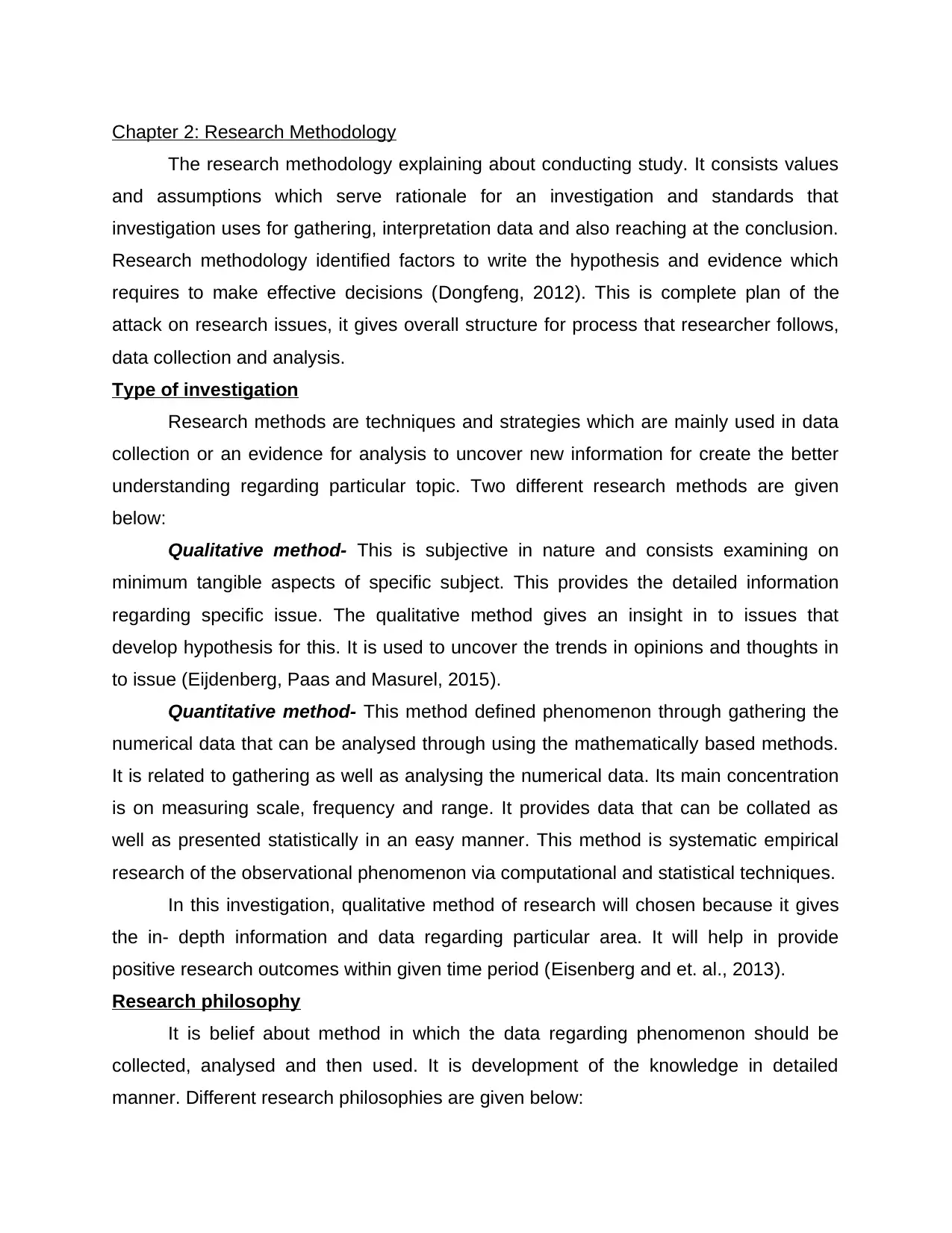
Chapter 2: Research Methodology
The research methodology explaining about conducting study. It consists values
and assumptions which serve rationale for an investigation and standards that
investigation uses for gathering, interpretation data and also reaching at the conclusion.
Research methodology identified factors to write the hypothesis and evidence which
requires to make effective decisions (Dongfeng, 2012). This is complete plan of the
attack on research issues, it gives overall structure for process that researcher follows,
data collection and analysis.
Type of investigation
Research methods are techniques and strategies which are mainly used in data
collection or an evidence for analysis to uncover new information for create the better
understanding regarding particular topic. Two different research methods are given
below:
Qualitative method- This is subjective in nature and consists examining on
minimum tangible aspects of specific subject. This provides the detailed information
regarding specific issue. The qualitative method gives an insight in to issues that
develop hypothesis for this. It is used to uncover the trends in opinions and thoughts in
to issue (Eijdenberg, Paas and Masurel, 2015).
Quantitative method- This method defined phenomenon through gathering the
numerical data that can be analysed through using the mathematically based methods.
It is related to gathering as well as analysing the numerical data. Its main concentration
is on measuring scale, frequency and range. It provides data that can be collated as
well as presented statistically in an easy manner. This method is systematic empirical
research of the observational phenomenon via computational and statistical techniques.
In this investigation, qualitative method of research will chosen because it gives
the in- depth information and data regarding particular area. It will help in provide
positive research outcomes within given time period (Eisenberg and et. al., 2013).
Research philosophy
It is belief about method in which the data regarding phenomenon should be
collected, analysed and then used. It is development of the knowledge in detailed
manner. Different research philosophies are given below:
The research methodology explaining about conducting study. It consists values
and assumptions which serve rationale for an investigation and standards that
investigation uses for gathering, interpretation data and also reaching at the conclusion.
Research methodology identified factors to write the hypothesis and evidence which
requires to make effective decisions (Dongfeng, 2012). This is complete plan of the
attack on research issues, it gives overall structure for process that researcher follows,
data collection and analysis.
Type of investigation
Research methods are techniques and strategies which are mainly used in data
collection or an evidence for analysis to uncover new information for create the better
understanding regarding particular topic. Two different research methods are given
below:
Qualitative method- This is subjective in nature and consists examining on
minimum tangible aspects of specific subject. This provides the detailed information
regarding specific issue. The qualitative method gives an insight in to issues that
develop hypothesis for this. It is used to uncover the trends in opinions and thoughts in
to issue (Eijdenberg, Paas and Masurel, 2015).
Quantitative method- This method defined phenomenon through gathering the
numerical data that can be analysed through using the mathematically based methods.
It is related to gathering as well as analysing the numerical data. Its main concentration
is on measuring scale, frequency and range. It provides data that can be collated as
well as presented statistically in an easy manner. This method is systematic empirical
research of the observational phenomenon via computational and statistical techniques.
In this investigation, qualitative method of research will chosen because it gives
the in- depth information and data regarding particular area. It will help in provide
positive research outcomes within given time period (Eisenberg and et. al., 2013).
Research philosophy
It is belief about method in which the data regarding phenomenon should be
collected, analysed and then used. It is development of the knowledge in detailed
manner. Different research philosophies are given below:
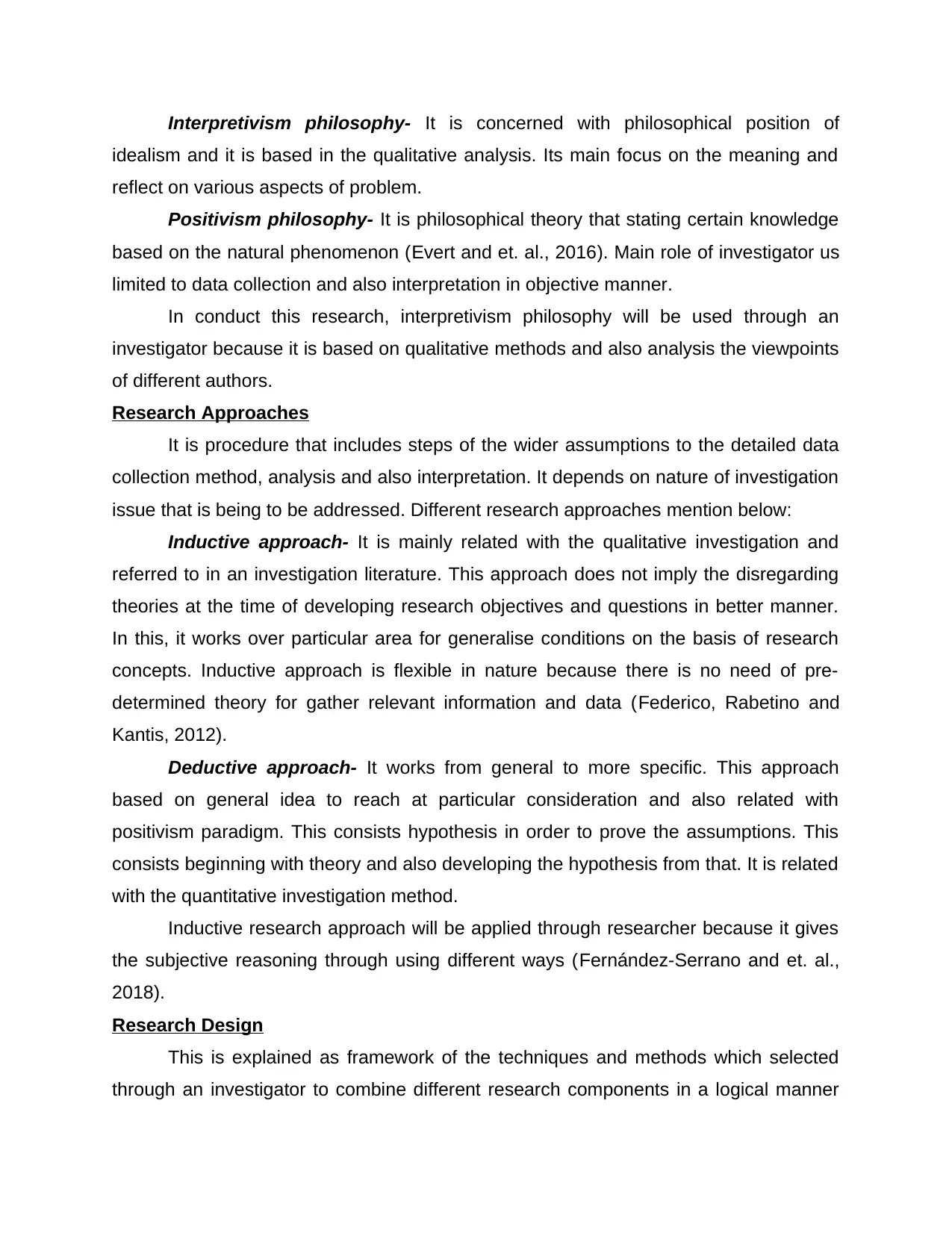
Interpretivism philosophy- It is concerned with philosophical position of
idealism and it is based in the qualitative analysis. Its main focus on the meaning and
reflect on various aspects of problem.
Positivism philosophy- It is philosophical theory that stating certain knowledge
based on the natural phenomenon (Evert and et. al., 2016). Main role of investigator us
limited to data collection and also interpretation in objective manner.
In conduct this research, interpretivism philosophy will be used through an
investigator because it is based on qualitative methods and also analysis the viewpoints
of different authors.
Research Approaches
It is procedure that includes steps of the wider assumptions to the detailed data
collection method, analysis and also interpretation. It depends on nature of investigation
issue that is being to be addressed. Different research approaches mention below:
Inductive approach- It is mainly related with the qualitative investigation and
referred to in an investigation literature. This approach does not imply the disregarding
theories at the time of developing research objectives and questions in better manner.
In this, it works over particular area for generalise conditions on the basis of research
concepts. Inductive approach is flexible in nature because there is no need of pre-
determined theory for gather relevant information and data (Federico, Rabetino and
Kantis, 2012).
Deductive approach- It works from general to more specific. This approach
based on general idea to reach at particular consideration and also related with
positivism paradigm. This consists hypothesis in order to prove the assumptions. This
consists beginning with theory and also developing the hypothesis from that. It is related
with the quantitative investigation method.
Inductive research approach will be applied through researcher because it gives
the subjective reasoning through using different ways (Fernández-Serrano and et. al.,
2018).
Research Design
This is explained as framework of the techniques and methods which selected
through an investigator to combine different research components in a logical manner
idealism and it is based in the qualitative analysis. Its main focus on the meaning and
reflect on various aspects of problem.
Positivism philosophy- It is philosophical theory that stating certain knowledge
based on the natural phenomenon (Evert and et. al., 2016). Main role of investigator us
limited to data collection and also interpretation in objective manner.
In conduct this research, interpretivism philosophy will be used through an
investigator because it is based on qualitative methods and also analysis the viewpoints
of different authors.
Research Approaches
It is procedure that includes steps of the wider assumptions to the detailed data
collection method, analysis and also interpretation. It depends on nature of investigation
issue that is being to be addressed. Different research approaches mention below:
Inductive approach- It is mainly related with the qualitative investigation and
referred to in an investigation literature. This approach does not imply the disregarding
theories at the time of developing research objectives and questions in better manner.
In this, it works over particular area for generalise conditions on the basis of research
concepts. Inductive approach is flexible in nature because there is no need of pre-
determined theory for gather relevant information and data (Federico, Rabetino and
Kantis, 2012).
Deductive approach- It works from general to more specific. This approach
based on general idea to reach at particular consideration and also related with
positivism paradigm. This consists hypothesis in order to prove the assumptions. This
consists beginning with theory and also developing the hypothesis from that. It is related
with the quantitative investigation method.
Inductive research approach will be applied through researcher because it gives
the subjective reasoning through using different ways (Fernández-Serrano and et. al.,
2018).
Research Design
This is explained as framework of the techniques and methods which selected
through an investigator to combine different research components in a logical manner
⊘ This is a preview!⊘
Do you want full access?
Subscribe today to unlock all pages.

Trusted by 1+ million students worldwide
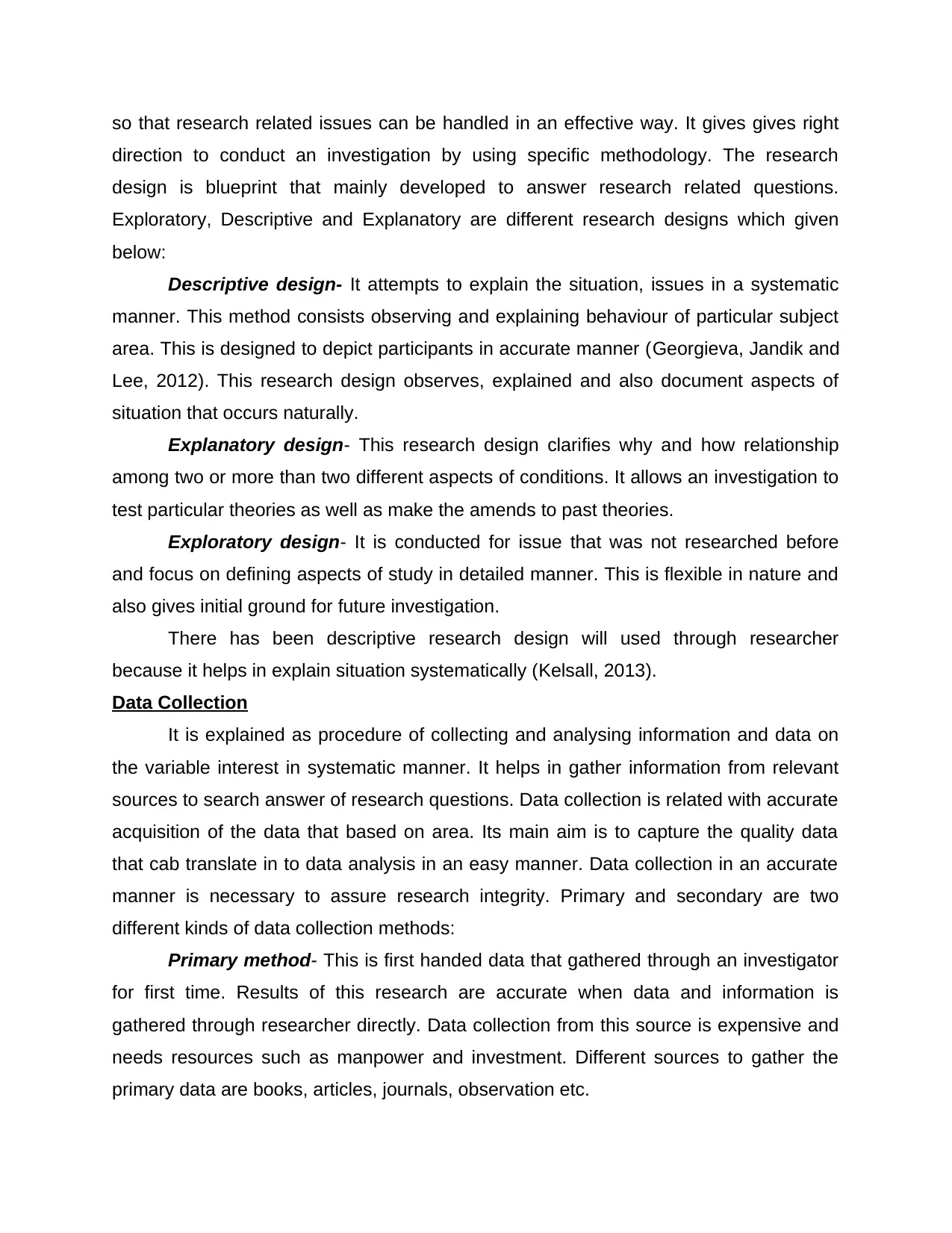
so that research related issues can be handled in an effective way. It gives gives right
direction to conduct an investigation by using specific methodology. The research
design is blueprint that mainly developed to answer research related questions.
Exploratory, Descriptive and Explanatory are different research designs which given
below:
Descriptive design- It attempts to explain the situation, issues in a systematic
manner. This method consists observing and explaining behaviour of particular subject
area. This is designed to depict participants in accurate manner (Georgieva, Jandik and
Lee, 2012). This research design observes, explained and also document aspects of
situation that occurs naturally.
Explanatory design- This research design clarifies why and how relationship
among two or more than two different aspects of conditions. It allows an investigation to
test particular theories as well as make the amends to past theories.
Exploratory design- It is conducted for issue that was not researched before
and focus on defining aspects of study in detailed manner. This is flexible in nature and
also gives initial ground for future investigation.
There has been descriptive research design will used through researcher
because it helps in explain situation systematically (Kelsall, 2013).
Data Collection
It is explained as procedure of collecting and analysing information and data on
the variable interest in systematic manner. It helps in gather information from relevant
sources to search answer of research questions. Data collection is related with accurate
acquisition of the data that based on area. Its main aim is to capture the quality data
that cab translate in to data analysis in an easy manner. Data collection in an accurate
manner is necessary to assure research integrity. Primary and secondary are two
different kinds of data collection methods:
Primary method- This is first handed data that gathered through an investigator
for first time. Results of this research are accurate when data and information is
gathered through researcher directly. Data collection from this source is expensive and
needs resources such as manpower and investment. Different sources to gather the
primary data are books, articles, journals, observation etc.
direction to conduct an investigation by using specific methodology. The research
design is blueprint that mainly developed to answer research related questions.
Exploratory, Descriptive and Explanatory are different research designs which given
below:
Descriptive design- It attempts to explain the situation, issues in a systematic
manner. This method consists observing and explaining behaviour of particular subject
area. This is designed to depict participants in accurate manner (Georgieva, Jandik and
Lee, 2012). This research design observes, explained and also document aspects of
situation that occurs naturally.
Explanatory design- This research design clarifies why and how relationship
among two or more than two different aspects of conditions. It allows an investigation to
test particular theories as well as make the amends to past theories.
Exploratory design- It is conducted for issue that was not researched before
and focus on defining aspects of study in detailed manner. This is flexible in nature and
also gives initial ground for future investigation.
There has been descriptive research design will used through researcher
because it helps in explain situation systematically (Kelsall, 2013).
Data Collection
It is explained as procedure of collecting and analysing information and data on
the variable interest in systematic manner. It helps in gather information from relevant
sources to search answer of research questions. Data collection is related with accurate
acquisition of the data that based on area. Its main aim is to capture the quality data
that cab translate in to data analysis in an easy manner. Data collection in an accurate
manner is necessary to assure research integrity. Primary and secondary are two
different kinds of data collection methods:
Primary method- This is first handed data that gathered through an investigator
for first time. Results of this research are accurate when data and information is
gathered through researcher directly. Data collection from this source is expensive and
needs resources such as manpower and investment. Different sources to gather the
primary data are books, articles, journals, observation etc.
Paraphrase This Document
Need a fresh take? Get an instant paraphrase of this document with our AI Paraphraser
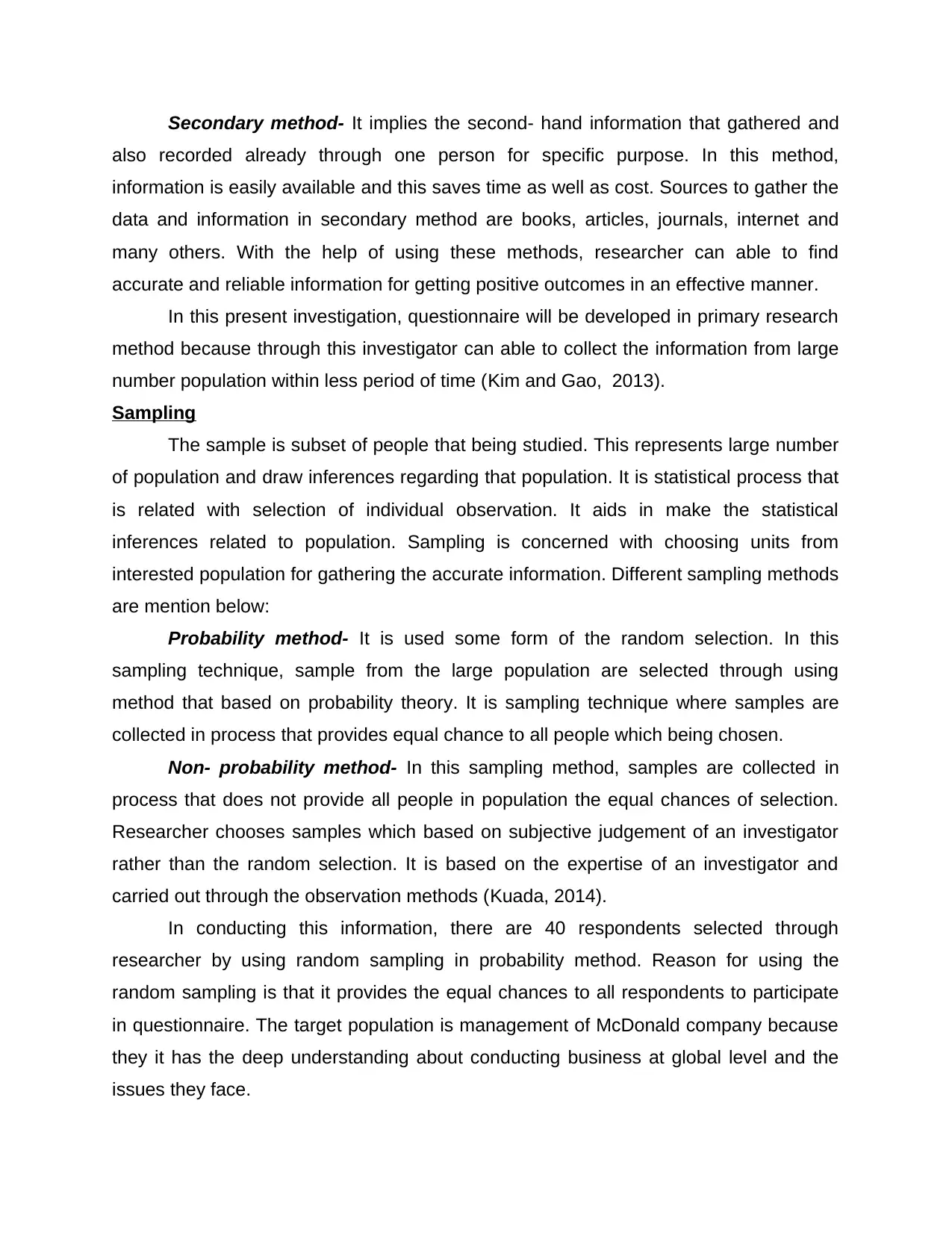
Secondary method- It implies the second- hand information that gathered and
also recorded already through one person for specific purpose. In this method,
information is easily available and this saves time as well as cost. Sources to gather the
data and information in secondary method are books, articles, journals, internet and
many others. With the help of using these methods, researcher can able to find
accurate and reliable information for getting positive outcomes in an effective manner.
In this present investigation, questionnaire will be developed in primary research
method because through this investigator can able to collect the information from large
number population within less period of time (Kim and Gao, 2013).
Sampling
The sample is subset of people that being studied. This represents large number
of population and draw inferences regarding that population. It is statistical process that
is related with selection of individual observation. It aids in make the statistical
inferences related to population. Sampling is concerned with choosing units from
interested population for gathering the accurate information. Different sampling methods
are mention below:
Probability method- It is used some form of the random selection. In this
sampling technique, sample from the large population are selected through using
method that based on probability theory. It is sampling technique where samples are
collected in process that provides equal chance to all people which being chosen.
Non- probability method- In this sampling method, samples are collected in
process that does not provide all people in population the equal chances of selection.
Researcher chooses samples which based on subjective judgement of an investigator
rather than the random selection. It is based on the expertise of an investigator and
carried out through the observation methods (Kuada, 2014).
In conducting this information, there are 40 respondents selected through
researcher by using random sampling in probability method. Reason for using the
random sampling is that it provides the equal chances to all respondents to participate
in questionnaire. The target population is management of McDonald company because
they it has the deep understanding about conducting business at global level and the
issues they face.
also recorded already through one person for specific purpose. In this method,
information is easily available and this saves time as well as cost. Sources to gather the
data and information in secondary method are books, articles, journals, internet and
many others. With the help of using these methods, researcher can able to find
accurate and reliable information for getting positive outcomes in an effective manner.
In this present investigation, questionnaire will be developed in primary research
method because through this investigator can able to collect the information from large
number population within less period of time (Kim and Gao, 2013).
Sampling
The sample is subset of people that being studied. This represents large number
of population and draw inferences regarding that population. It is statistical process that
is related with selection of individual observation. It aids in make the statistical
inferences related to population. Sampling is concerned with choosing units from
interested population for gathering the accurate information. Different sampling methods
are mention below:
Probability method- It is used some form of the random selection. In this
sampling technique, sample from the large population are selected through using
method that based on probability theory. It is sampling technique where samples are
collected in process that provides equal chance to all people which being chosen.
Non- probability method- In this sampling method, samples are collected in
process that does not provide all people in population the equal chances of selection.
Researcher chooses samples which based on subjective judgement of an investigator
rather than the random selection. It is based on the expertise of an investigator and
carried out through the observation methods (Kuada, 2014).
In conducting this information, there are 40 respondents selected through
researcher by using random sampling in probability method. Reason for using the
random sampling is that it provides the equal chances to all respondents to participate
in questionnaire. The target population is management of McDonald company because
they it has the deep understanding about conducting business at global level and the
issues they face.
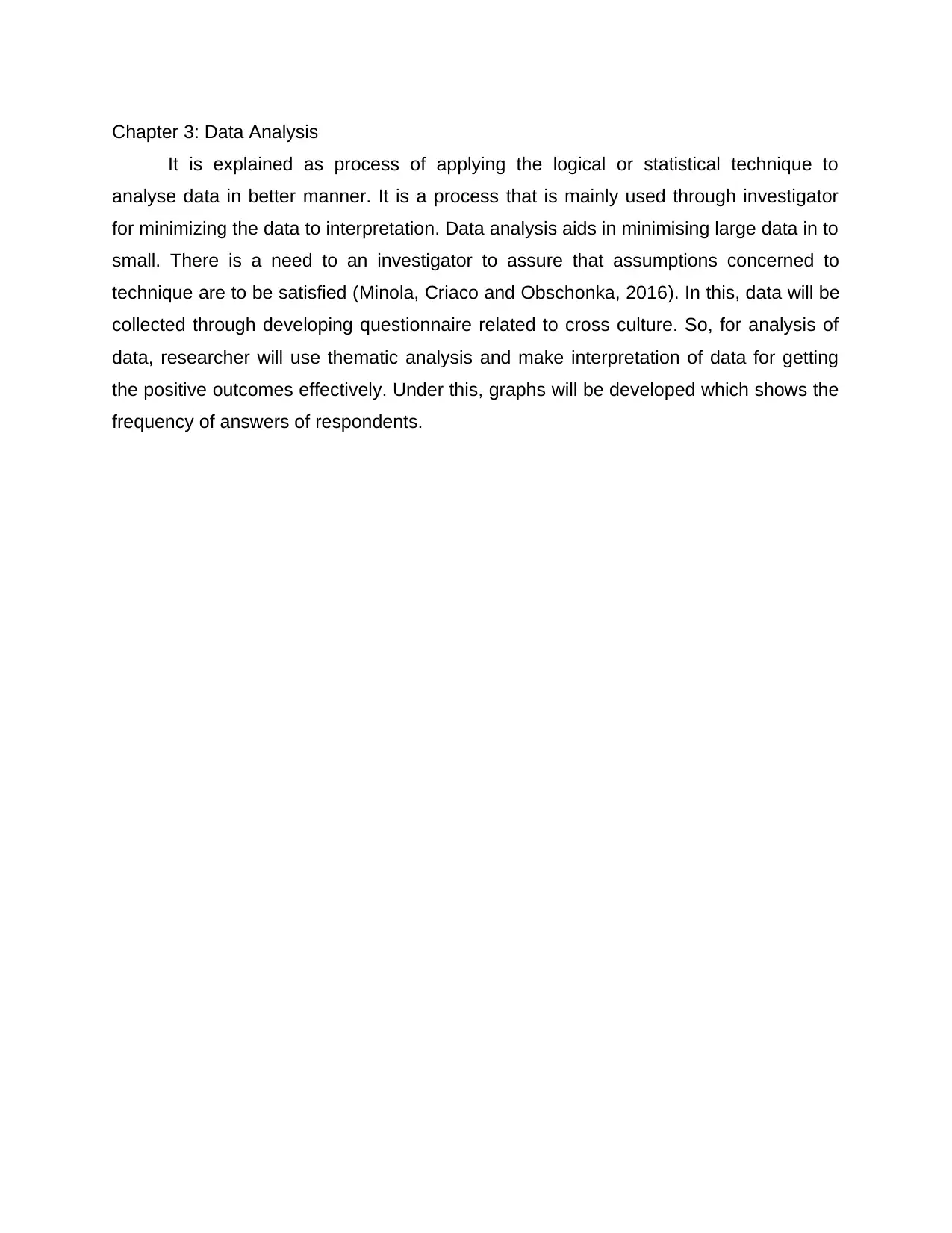
Chapter 3: Data Analysis
It is explained as process of applying the logical or statistical technique to
analyse data in better manner. It is a process that is mainly used through investigator
for minimizing the data to interpretation. Data analysis aids in minimising large data in to
small. There is a need to an investigator to assure that assumptions concerned to
technique are to be satisfied (Minola, Criaco and Obschonka, 2016). In this, data will be
collected through developing questionnaire related to cross culture. So, for analysis of
data, researcher will use thematic analysis and make interpretation of data for getting
the positive outcomes effectively. Under this, graphs will be developed which shows the
frequency of answers of respondents.
It is explained as process of applying the logical or statistical technique to
analyse data in better manner. It is a process that is mainly used through investigator
for minimizing the data to interpretation. Data analysis aids in minimising large data in to
small. There is a need to an investigator to assure that assumptions concerned to
technique are to be satisfied (Minola, Criaco and Obschonka, 2016). In this, data will be
collected through developing questionnaire related to cross culture. So, for analysis of
data, researcher will use thematic analysis and make interpretation of data for getting
the positive outcomes effectively. Under this, graphs will be developed which shows the
frequency of answers of respondents.
⊘ This is a preview!⊘
Do you want full access?
Subscribe today to unlock all pages.

Trusted by 1+ million students worldwide
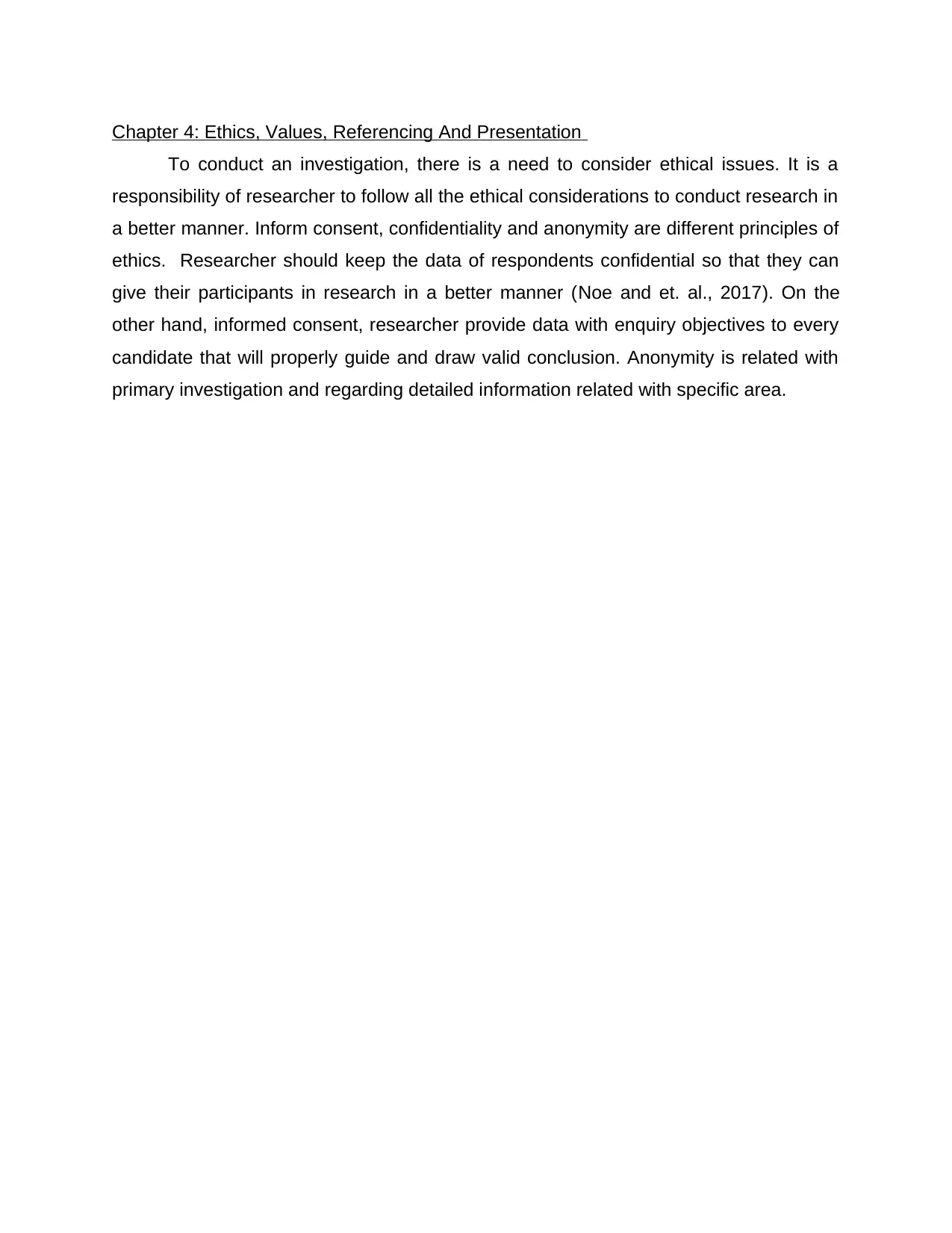
Chapter 4: Ethics, Values, Referencing And Presentation
To conduct an investigation, there is a need to consider ethical issues. It is a
responsibility of researcher to follow all the ethical considerations to conduct research in
a better manner. Inform consent, confidentiality and anonymity are different principles of
ethics. Researcher should keep the data of respondents confidential so that they can
give their participants in research in a better manner (Noe and et. al., 2017). On the
other hand, informed consent, researcher provide data with enquiry objectives to every
candidate that will properly guide and draw valid conclusion. Anonymity is related with
primary investigation and regarding detailed information related with specific area.
To conduct an investigation, there is a need to consider ethical issues. It is a
responsibility of researcher to follow all the ethical considerations to conduct research in
a better manner. Inform consent, confidentiality and anonymity are different principles of
ethics. Researcher should keep the data of respondents confidential so that they can
give their participants in research in a better manner (Noe and et. al., 2017). On the
other hand, informed consent, researcher provide data with enquiry objectives to every
candidate that will properly guide and draw valid conclusion. Anonymity is related with
primary investigation and regarding detailed information related with specific area.
Paraphrase This Document
Need a fresh take? Get an instant paraphrase of this document with our AI Paraphraser
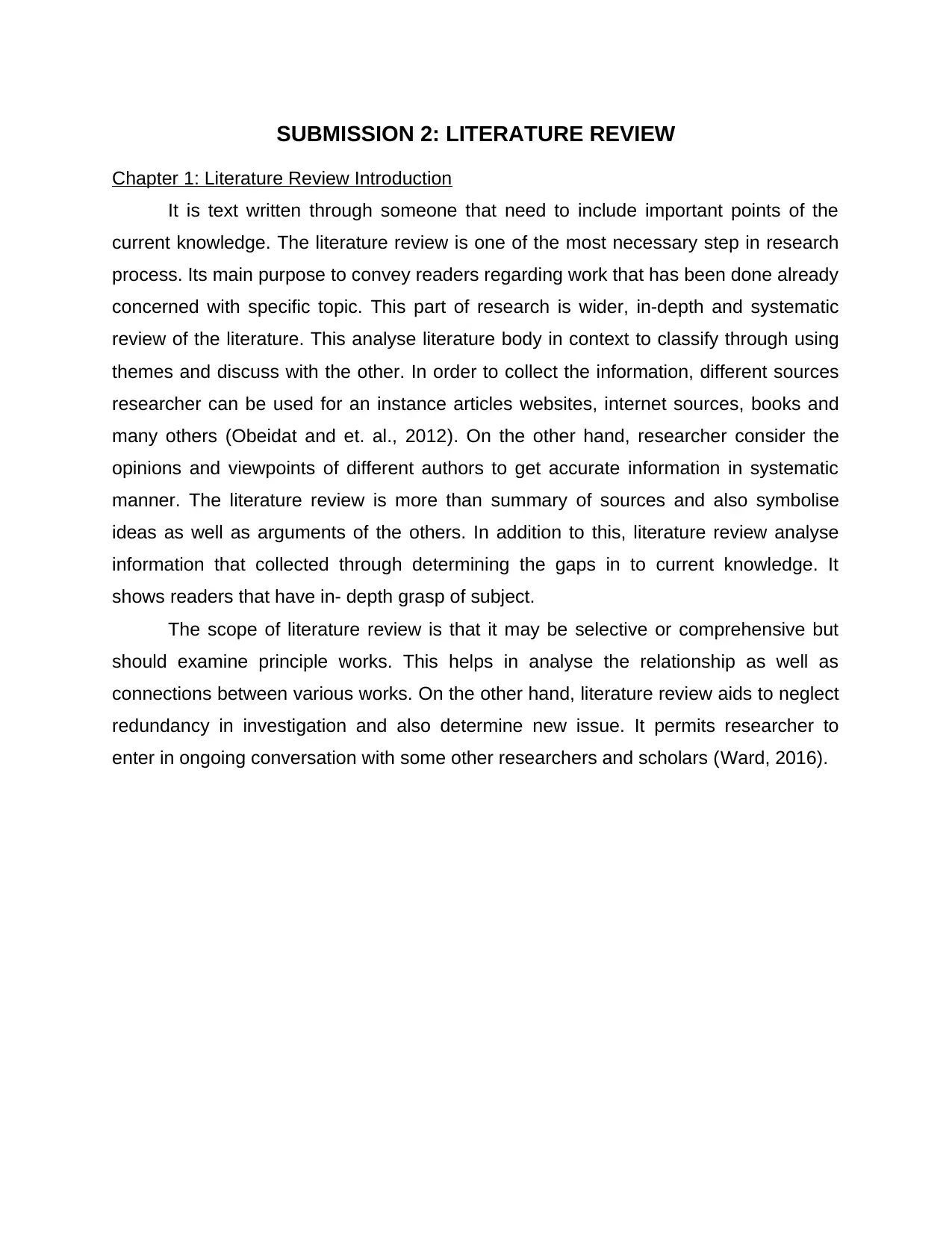
SUBMISSION 2: LITERATURE REVIEW
Chapter 1: Literature Review Introduction
It is text written through someone that need to include important points of the
current knowledge. The literature review is one of the most necessary step in research
process. Its main purpose to convey readers regarding work that has been done already
concerned with specific topic. This part of research is wider, in-depth and systematic
review of the literature. This analyse literature body in context to classify through using
themes and discuss with the other. In order to collect the information, different sources
researcher can be used for an instance articles websites, internet sources, books and
many others (Obeidat and et. al., 2012). On the other hand, researcher consider the
opinions and viewpoints of different authors to get accurate information in systematic
manner. The literature review is more than summary of sources and also symbolise
ideas as well as arguments of the others. In addition to this, literature review analyse
information that collected through determining the gaps in to current knowledge. It
shows readers that have in- depth grasp of subject.
The scope of literature review is that it may be selective or comprehensive but
should examine principle works. This helps in analyse the relationship as well as
connections between various works. On the other hand, literature review aids to neglect
redundancy in investigation and also determine new issue. It permits researcher to
enter in ongoing conversation with some other researchers and scholars (Ward, 2016).
Chapter 1: Literature Review Introduction
It is text written through someone that need to include important points of the
current knowledge. The literature review is one of the most necessary step in research
process. Its main purpose to convey readers regarding work that has been done already
concerned with specific topic. This part of research is wider, in-depth and systematic
review of the literature. This analyse literature body in context to classify through using
themes and discuss with the other. In order to collect the information, different sources
researcher can be used for an instance articles websites, internet sources, books and
many others (Obeidat and et. al., 2012). On the other hand, researcher consider the
opinions and viewpoints of different authors to get accurate information in systematic
manner. The literature review is more than summary of sources and also symbolise
ideas as well as arguments of the others. In addition to this, literature review analyse
information that collected through determining the gaps in to current knowledge. It
shows readers that have in- depth grasp of subject.
The scope of literature review is that it may be selective or comprehensive but
should examine principle works. This helps in analyse the relationship as well as
connections between various works. On the other hand, literature review aids to neglect
redundancy in investigation and also determine new issue. It permits researcher to
enter in ongoing conversation with some other researchers and scholars (Ward, 2016).
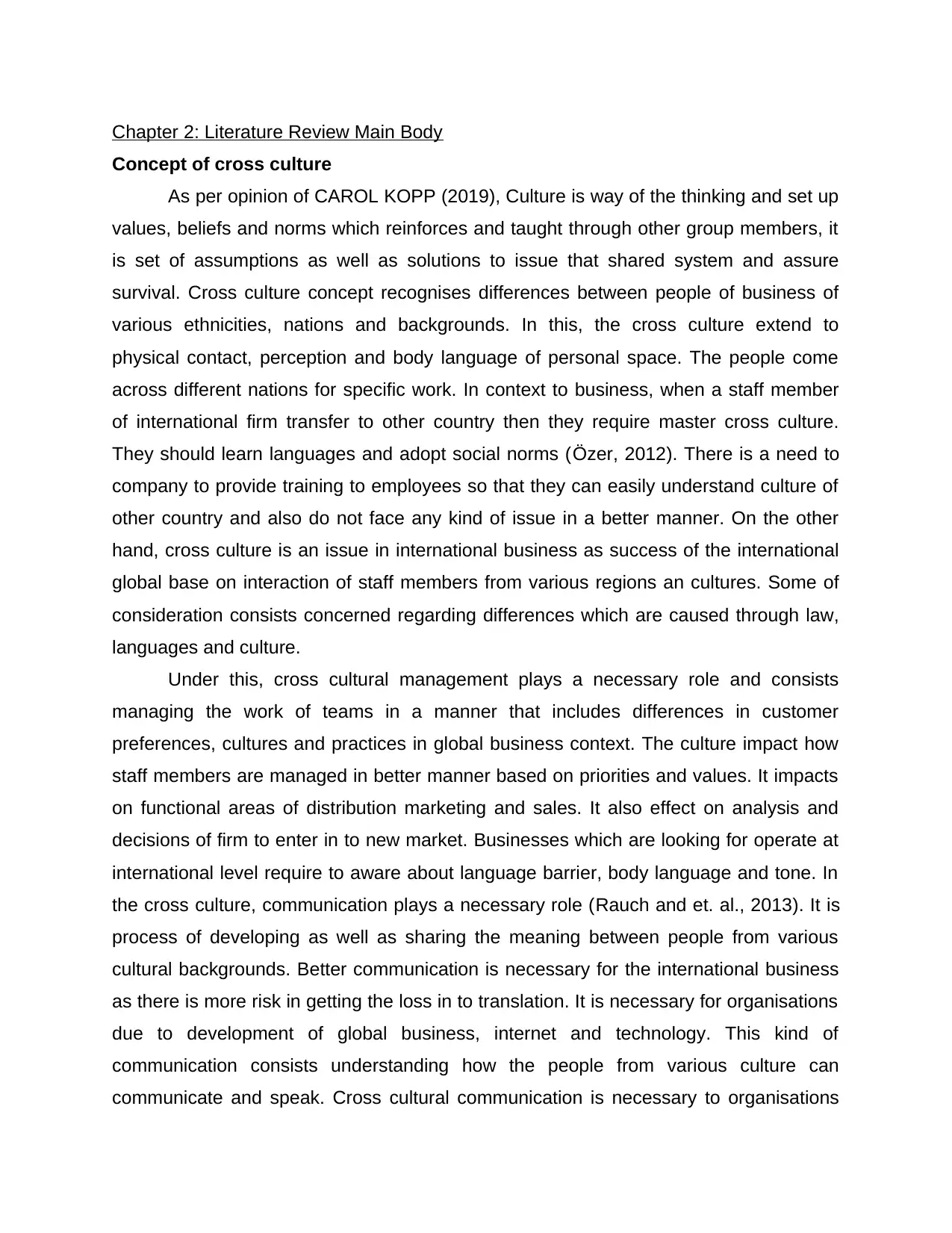
Chapter 2: Literature Review Main Body
Concept of cross culture
As per opinion of CAROL KOPP (2019), Culture is way of the thinking and set up
values, beliefs and norms which reinforces and taught through other group members, it
is set of assumptions as well as solutions to issue that shared system and assure
survival. Cross culture concept recognises differences between people of business of
various ethnicities, nations and backgrounds. In this, the cross culture extend to
physical contact, perception and body language of personal space. The people come
across different nations for specific work. In context to business, when a staff member
of international firm transfer to other country then they require master cross culture.
They should learn languages and adopt social norms (Özer, 2012). There is a need to
company to provide training to employees so that they can easily understand culture of
other country and also do not face any kind of issue in a better manner. On the other
hand, cross culture is an issue in international business as success of the international
global base on interaction of staff members from various regions an cultures. Some of
consideration consists concerned regarding differences which are caused through law,
languages and culture.
Under this, cross cultural management plays a necessary role and consists
managing the work of teams in a manner that includes differences in customer
preferences, cultures and practices in global business context. The culture impact how
staff members are managed in better manner based on priorities and values. It impacts
on functional areas of distribution marketing and sales. It also effect on analysis and
decisions of firm to enter in to new market. Businesses which are looking for operate at
international level require to aware about language barrier, body language and tone. In
the cross culture, communication plays a necessary role (Rauch and et. al., 2013). It is
process of developing as well as sharing the meaning between people from various
cultural backgrounds. Better communication is necessary for the international business
as there is more risk in getting the loss in to translation. It is necessary for organisations
due to development of global business, internet and technology. This kind of
communication consists understanding how the people from various culture can
communicate and speak. Cross cultural communication is necessary to organisations
Concept of cross culture
As per opinion of CAROL KOPP (2019), Culture is way of the thinking and set up
values, beliefs and norms which reinforces and taught through other group members, it
is set of assumptions as well as solutions to issue that shared system and assure
survival. Cross culture concept recognises differences between people of business of
various ethnicities, nations and backgrounds. In this, the cross culture extend to
physical contact, perception and body language of personal space. The people come
across different nations for specific work. In context to business, when a staff member
of international firm transfer to other country then they require master cross culture.
They should learn languages and adopt social norms (Özer, 2012). There is a need to
company to provide training to employees so that they can easily understand culture of
other country and also do not face any kind of issue in a better manner. On the other
hand, cross culture is an issue in international business as success of the international
global base on interaction of staff members from various regions an cultures. Some of
consideration consists concerned regarding differences which are caused through law,
languages and culture.
Under this, cross cultural management plays a necessary role and consists
managing the work of teams in a manner that includes differences in customer
preferences, cultures and practices in global business context. The culture impact how
staff members are managed in better manner based on priorities and values. It impacts
on functional areas of distribution marketing and sales. It also effect on analysis and
decisions of firm to enter in to new market. Businesses which are looking for operate at
international level require to aware about language barrier, body language and tone. In
the cross culture, communication plays a necessary role (Rauch and et. al., 2013). It is
process of developing as well as sharing the meaning between people from various
cultural backgrounds. Better communication is necessary for the international business
as there is more risk in getting the loss in to translation. It is necessary for organisations
due to development of global business, internet and technology. This kind of
communication consists understanding how the people from various culture can
communicate and speak. Cross cultural communication is necessary to organisations
⊘ This is a preview!⊘
Do you want full access?
Subscribe today to unlock all pages.

Trusted by 1+ million students worldwide
1 out of 19
Related Documents
Your All-in-One AI-Powered Toolkit for Academic Success.
+13062052269
info@desklib.com
Available 24*7 on WhatsApp / Email
![[object Object]](/_next/static/media/star-bottom.7253800d.svg)
Unlock your academic potential
Copyright © 2020–2025 A2Z Services. All Rights Reserved. Developed and managed by ZUCOL.





